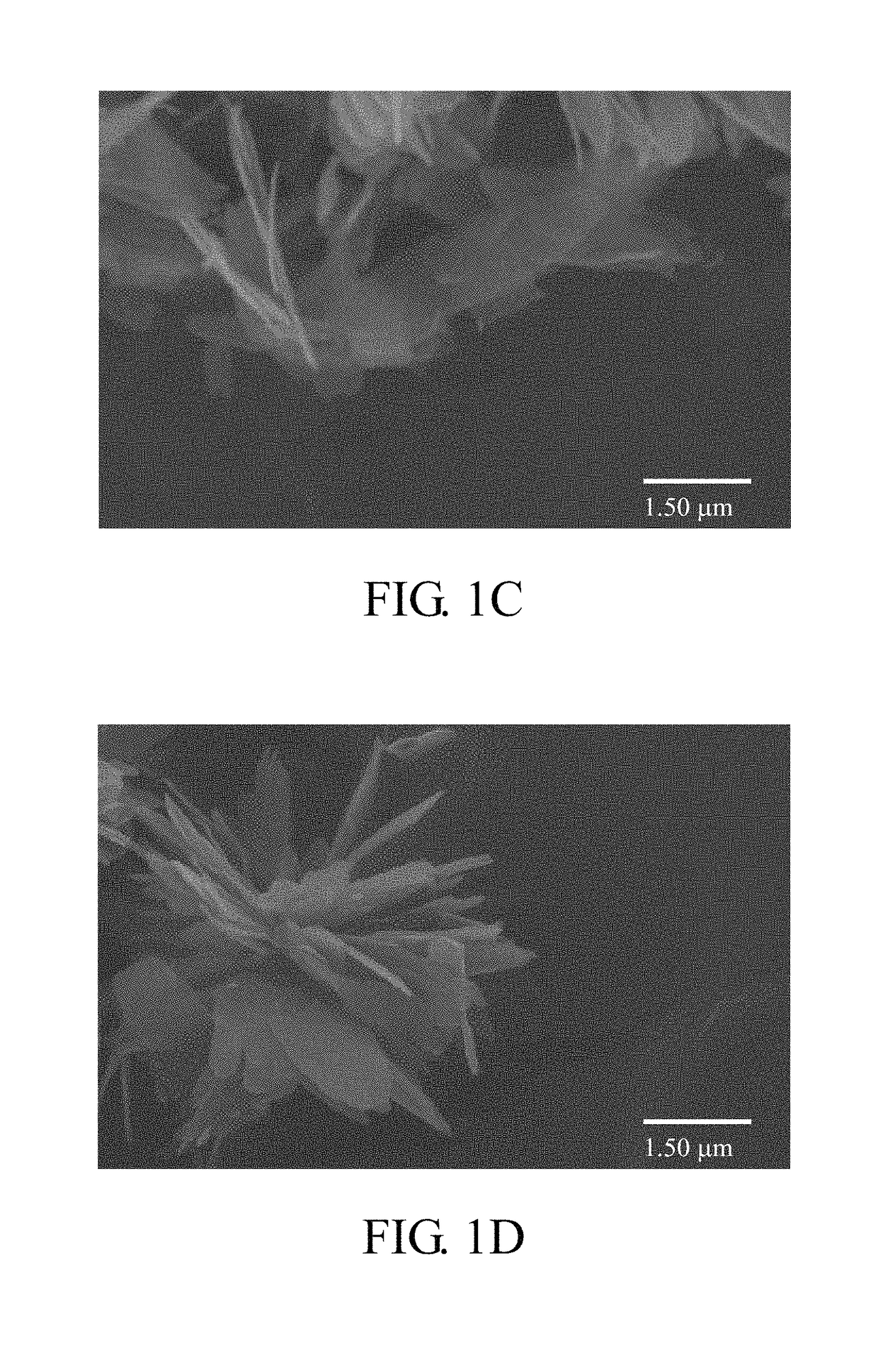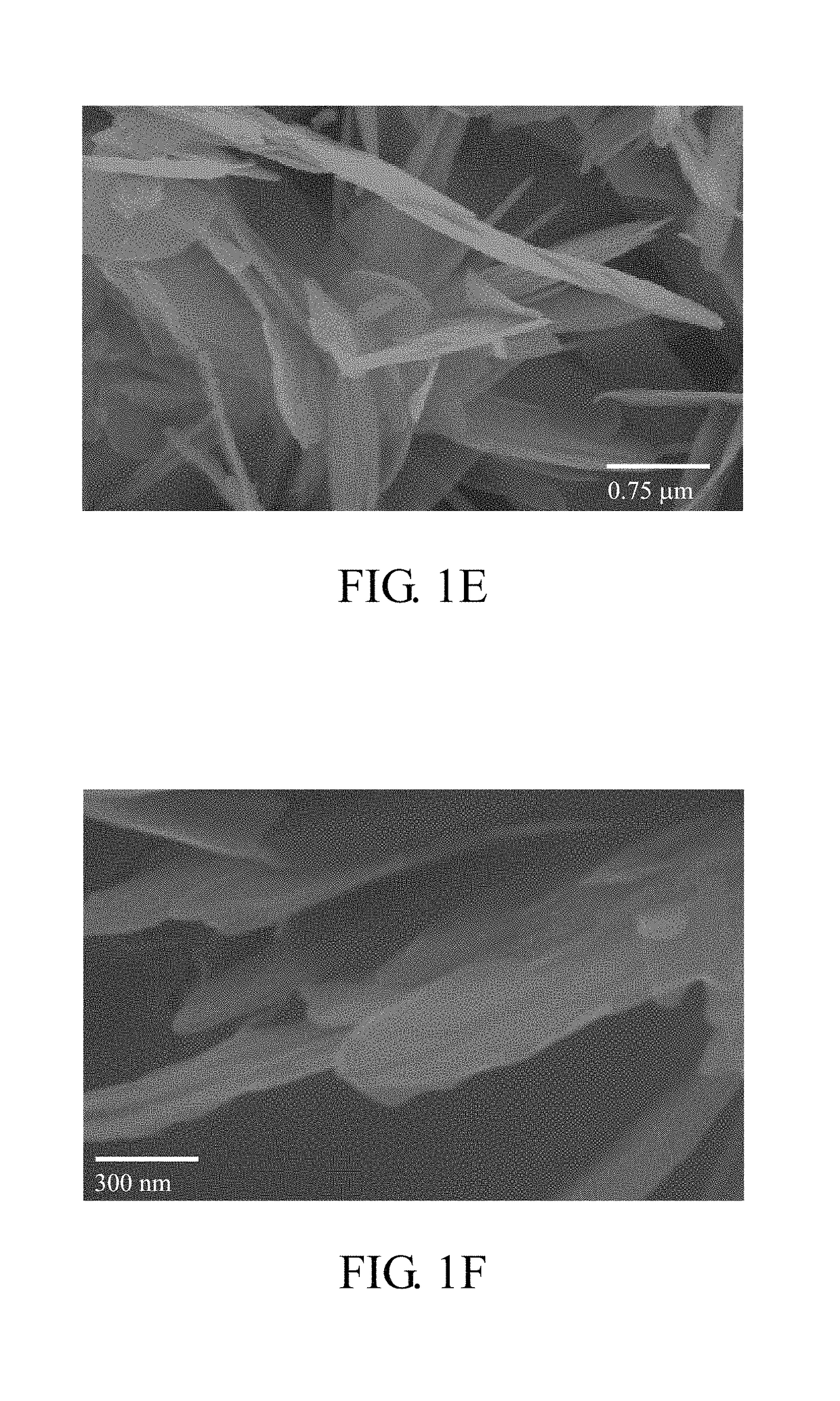Ferrous phosphate powders, lithium iron phosphate powders for li-ion battery, and methods for manufacturing the same
a technology of iron phosphate and lithium iron phosphate, which is applied in the direction of non-metal conductors, cell components, electrochemical generators, etc., can solve the problems of large and non-uniform grain size of lifepo/sub>powders, increase the cost of li-ion batteries, and collapse of the spinal structure of limn/sub>2/sub>o/sub>4, so as to achieve the effect of small lithium iron
- Summary
- Abstract
- Description
- Claims
- Application Information
AI Technical Summary
Benefits of technology
Problems solved by technology
Method used
Image
Examples
embodiment 1
Preparation of Ferrous (II) Phosphate Powders
[0067]H3PO4 was added in de-ionized water (500 ml) to obtain a P-containing precursor solution. Next, NaHCO3 was added into the P-containing precursor solution to obtain a mixture, in which the molar ratio of H3PO4 to NaHCO3 was 1:3. After the mixture was stirred for 30 min, ferrous sulfate hydrate (FeSO4.8H2O) was added into the mixture, wherein the molar ratio of FeSO4.8H2O to H3PO4 was 3:2. After the reaction was completed, the product was washed with deionized water, and then collected with centrifugation for twice. After the collected product was dried at 55° C. for 45 hours, ferrous (II) phosphate precursor powders (Fe3(PO4)2.8H2O) were obtained.
[0068]The shapes of the ferrous phosphate (II) powders of the present embodiment were observed with a scanning electron microscope (SEM) (Hitachi S-4000), and the results are shown in FIGS. 1A-1F, which are SEM photos of ferrous (II) phosphate powders observed at the magnification of 1,000×,...
embodiment 2
Preparation of Ferrous (II) Phosphate Powders
[0076]H3PO4 was added in deionized water (500 ml) to obtain a P-containing precursor solution. Next, NaHCO3 was added into the P-containing precursor solution to obtain a mixture, in which the molar ratio of H3PO4 to NaHCO3 was 1:3. After the mixture was stirred for 30 min, ferrous sulfate hydrate (FeSO4.8H2O) and manganese sulfate hydrate (MnSO4.5H2O) was added into the mixture, wherein the molar ratio of FeSO4.8H2O to MnSO4.6H2O was 9:1, and the molar ratio of the total amount of FeSO4.8H2O and MgSO4.6H2O to H3PO4 was 3:2. After the reaction was completed, the product was washed with deionized water, and then collected with centrifugation twice. After the collected product was dried at 55° C. for at least 36 hours, ferrous (II) phosphate precursor powders doped with Mn (Fe2.7Mn0.3(PO4)2.8H2O) were obtained.
[0077]The shapes of the ferrous (II) phosphate precursor powders doped with Mn of the present embodiment were also observed with a s...
embodiment 3
[0081]The ferrous (II) phosphate precursor powders doped with Mg of the present embodiment were prepared through the same process as illustrated in Embodiment 2, except that the MnSO4.5H2O was substituted with magnesium nitrate hydrate (MgN2O6.6H2O) in the present embodiment. In addition, the lithium iron phosphate powders doped with Mg of the present embodiment were also prepared through the same process as illustrated in Embodiment 2, except that the ferrous (II) phosphate precursor powders doped with Mn used in the Embodiment 2 were substituted with ferrous (II) phosphate precursor powders doped with Mg prepared in the present embodiment.
[0082]After preparation, ferrous (II) phosphate precursor powders doped with Mg (Fe2.7Mg0.3(PO4)2.8H2O) and lithium iron phosphate powders coated with carbon and doped with Mg (LiFe0.9Mg0.1PO4 / C) were obtained.
[0083]The shapes of the ferrous (II) phosphate precursor powders and lithium iron phosphate powders doped with Mg of the present embodimen...
PUM
| Property | Measurement | Unit |
|---|---|---|
| length | aaaaa | aaaaa |
| thickness | aaaaa | aaaaa |
| grain size | aaaaa | aaaaa |
Abstract
Description
Claims
Application Information
 Login to View More
Login to View More - R&D
- Intellectual Property
- Life Sciences
- Materials
- Tech Scout
- Unparalleled Data Quality
- Higher Quality Content
- 60% Fewer Hallucinations
Browse by: Latest US Patents, China's latest patents, Technical Efficacy Thesaurus, Application Domain, Technology Topic, Popular Technical Reports.
© 2025 PatSnap. All rights reserved.Legal|Privacy policy|Modern Slavery Act Transparency Statement|Sitemap|About US| Contact US: help@patsnap.com



